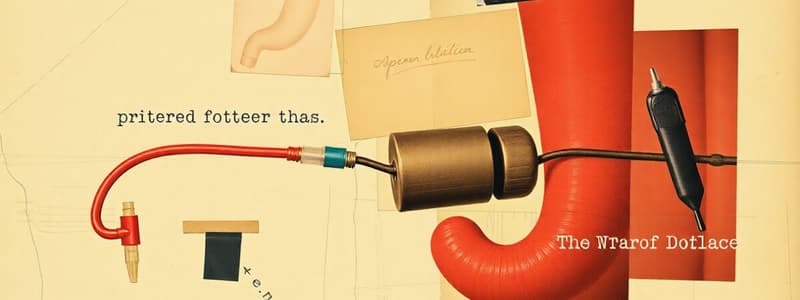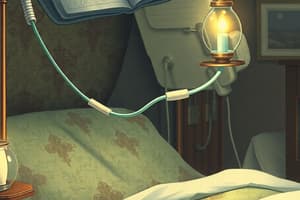Podcast
Questions and Answers
What is the primary purpose of a nasogastric (NG) tube?
What is the primary purpose of a nasogastric (NG) tube?
- To provide access to the stomach for removing contents or providing nutrition/medications. (correct)
- To assist with upper respiratory function and clear blockages in the nasal passage.
- To monitor cardiac activity via the esophagus.
- To deliver oxygen directly to the lungs.
Which of the following actions is within the Registered Nurse's (RN) scope of practice when managing a patient with an NG tube?
Which of the following actions is within the Registered Nurse's (RN) scope of practice when managing a patient with an NG tube?
- Delegating the entire care and maintenance of the NG tube to assistive personnel (AP).
- Prescribing medication dosages to be administered through the NG tube, in coordination with the physician.
- Supervising unlicensed personnel in performing NG tube insertion.
- Assessing feeding tolerance and evaluating skin integrity around the nares. (correct)
A nurse is preparing to verify the placement of a newly inserted NG tube. While radiographic confirmation is the gold standard, what bedside method provides an initial assessment of correct placement?
A nurse is preparing to verify the placement of a newly inserted NG tube. While radiographic confirmation is the gold standard, what bedside method provides an initial assessment of correct placement?
- Auscultating over the epigastric area while injecting air into NG tube.
- Aspirating gastric contents and testing the pH. (correct)
- Measuring the length of the exposed NG tube and comparing it to the insertion measurement.
- Observing the client for increased respiratory rate and effort.
What is the most important rationale for flushing an NG tube?
What is the most important rationale for flushing an NG tube?
Why is it essential to assess a client's nares and surrounding skin when caring for an NG tube?
Why is it essential to assess a client's nares and surrounding skin when caring for an NG tube?
A nurse is preparing to administer medication through an NG tube. What is the MOST appropriate position for the client during and immediately after the medication administration?
A nurse is preparing to administer medication through an NG tube. What is the MOST appropriate position for the client during and immediately after the medication administration?
Before initiating an intermittent feeding via NG tube, the nurse aspirates 75 mL of gastric residual volume. What action should the nurse take FIRST?
Before initiating an intermittent feeding via NG tube, the nurse aspirates 75 mL of gastric residual volume. What action should the nurse take FIRST?
A nurse is providing oral care to a client with an NG tube. Why is this intervention a priority?
A nurse is providing oral care to a client with an NG tube. Why is this intervention a priority?
During NG tube care, a nurse notes that the client is experiencing persistent coughing and gagging. What is the MOST appropriate action?
During NG tube care, a nurse notes that the client is experiencing persistent coughing and gagging. What is the MOST appropriate action?
When documenting NG tube care, which of the following elements is MOST important to include?
When documenting NG tube care, which of the following elements is MOST important to include?
A nurse is educating a client and their family on the care of a newly placed NG tube for home use. Which key instruction should be emphasized to ensure client safety?
A nurse is educating a client and their family on the care of a newly placed NG tube for home use. Which key instruction should be emphasized to ensure client safety?
A client with an NG tube suddenly develops respiratory distress. After quickly assessing the client, what is the nurse's priority action?
A client with an NG tube suddenly develops respiratory distress. After quickly assessing the client, what is the nurse's priority action?
During routine NG tube maintenance, it is noted that the adhesive tape securing the tube to the client's nose is no longer effective, causing the tube to move excessively. What is the appropriate nursing intervention?
During routine NG tube maintenance, it is noted that the adhesive tape securing the tube to the client's nose is no longer effective, causing the tube to move excessively. What is the appropriate nursing intervention?
A nurse is unable to aspirate gastric contents from an NG tube to verify placement. Which of the following interventions should the nurse attempt FIRST?
A nurse is unable to aspirate gastric contents from an NG tube to verify placement. Which of the following interventions should the nurse attempt FIRST?
When discontinuing an NG tube, what is the correct sequence of actions the nurse should perform?
When discontinuing an NG tube, what is the correct sequence of actions the nurse should perform?
What is the primary rationale for verifying a client's allergy status before initiating NG tube care?
What is the primary rationale for verifying a client's allergy status before initiating NG tube care?
A nurse is caring for a neonate with an NG tube. Why is frequent assessment of the neonate’s oxygen saturation levels particularly important?
A nurse is caring for a neonate with an NG tube. Why is frequent assessment of the neonate’s oxygen saturation levels particularly important?
What documentation should a nurse prioritize after resecuring an NG tube that was at risk for displacement?
What documentation should a nurse prioritize after resecuring an NG tube that was at risk for displacement?
A nurse is providing NG tube care for a client who recently had head and neck surgery. What specific precaution should the nurse take in this situation?
A nurse is providing NG tube care for a client who recently had head and neck surgery. What specific precaution should the nurse take in this situation?
A nurse is preparing to irrigate an NG tube. Which of the following solutions is typically recommended for irrigation?
A nurse is preparing to irrigate an NG tube. Which of the following solutions is typically recommended for irrigation?
When a client with an NG tube reports nausea and abdominal distension, what should the nurse assess FIRST to address these symptoms?
When a client with an NG tube reports nausea and abdominal distension, what should the nurse assess FIRST to address these symptoms?
What is the MOST effective strategy to prevent skin breakdown around the nares in a client with a nasogastric tube?
What is the MOST effective strategy to prevent skin breakdown around the nares in a client with a nasogastric tube?
A nurse is preparing to administer medication via NG tube to a client who is receiving continuous enteral feedings. What is the MOST appropriate action to prevent medication-food interactions and ensure accurate medication delivery?
A nurse is preparing to administer medication via NG tube to a client who is receiving continuous enteral feedings. What is the MOST appropriate action to prevent medication-food interactions and ensure accurate medication delivery?
A client with an NG tube is ordered intermittent suction. What nursing action is MOST important to prevent mucosal damage?
A client with an NG tube is ordered intermittent suction. What nursing action is MOST important to prevent mucosal damage?
When providing education to a client with a newly inserted NG tube, what would the nurse emphasize regarding when to contact the healthcare provider?
When providing education to a client with a newly inserted NG tube, what would the nurse emphasize regarding when to contact the healthcare provider?
A nurse is assessing a client with an NG tube and notes the gastric aspirate is a dark coffee-ground color. What does this finding indicate?
A nurse is assessing a client with an NG tube and notes the gastric aspirate is a dark coffee-ground color. What does this finding indicate?
A client receiving continuous enteral feedings via NG tube develops diarrhea. What is the FIRST action the nurse should take?
A client receiving continuous enteral feedings via NG tube develops diarrhea. What is the FIRST action the nurse should take?
What instruction should a nurse provide to a client just prior to removing a nasogastric tube?
What instruction should a nurse provide to a client just prior to removing a nasogastric tube?
A nurse is caring for a client with an NG tube attached to low intermittent suction. The client reports persistent heartburn. What intervention is MOST appropriate?
A nurse is caring for a client with an NG tube attached to low intermittent suction. The client reports persistent heartburn. What intervention is MOST appropriate?
A nurse is caring for a client with an NG tube who is also receiving oxygen therapy. Which intervention is MOST important to prevent mucosal drying and maintain client comfort?
A nurse is caring for a client with an NG tube who is also receiving oxygen therapy. Which intervention is MOST important to prevent mucosal drying and maintain client comfort?
A nurse is preparing to administer several medications through an NG tube. Which of the following nursing actions is MOST appropriate to ensure proper administration?
A nurse is preparing to administer several medications through an NG tube. Which of the following nursing actions is MOST appropriate to ensure proper administration?
A nurse is caring for a client with an NG tube who is also receiving intermittent bolus feedings. Which of the following nursing actions is MOST important to prevent aspiration?
A nurse is caring for a client with an NG tube who is also receiving intermittent bolus feedings. Which of the following nursing actions is MOST important to prevent aspiration?
A nurse is providing education to a client being discharged home with a newly placed NG tube for continuous feeding. What is the MOST important point to emphasize?
A nurse is providing education to a client being discharged home with a newly placed NG tube for continuous feeding. What is the MOST important point to emphasize?
Flashcards
Nasogastric (NG) Tube
Nasogastric (NG) Tube
A flexible tube inserted through the nose into the stomach, used for removing contents or providing nutrition/medications.
NG Tube Care
NG Tube Care
Verifying placement, maintaining patency, assessing tolerance, evaluating skin integrity, oral care, client education, and ensuring safety.
Check Allergies
Check Allergies
To prevent allergic reactions.
Verify Client ID
Verify Client ID
Signup and view all the flashcards
Use Standard Precautions
Use Standard Precautions
Signup and view all the flashcards
Verify NG Tube Placement
Verify NG Tube Placement
Signup and view all the flashcards
NG Tube Flushing Equipment
NG Tube Flushing Equipment
Signup and view all the flashcards
Resecuring NG Tube Equipment
Resecuring NG Tube Equipment
Signup and view all the flashcards
Oral/Nares Care Equipment
Oral/Nares Care Equipment
Signup and view all the flashcards
Emesis Basin Use
Emesis Basin Use
Signup and view all the flashcards
Review Medical Record
Review Medical Record
Signup and view all the flashcards
Provide Privacy
Provide Privacy
Signup and view all the flashcards
Introduce Yourself
Introduce Yourself
Signup and view all the flashcards
Confirm Allergy Status
Confirm Allergy Status
Signup and view all the flashcards
Provide Client Education
Provide Client Education
Signup and view all the flashcards
Hydration/Skin Integrity
Hydration/Skin Integrity
Signup and view all the flashcards
Check Indelible Mark
Check Indelible Mark
Signup and view all the flashcards
Tape to Gown
Tape to Gown
Signup and view all the flashcards
Free of Kinks
Free of Kinks
Signup and view all the flashcards
Signs of Gastric Issues
Signs of Gastric Issues
Signup and view all the flashcards
Respiratory Distress
Respiratory Distress
Signup and view all the flashcards
No Gastric Contents
No Gastric Contents
Signup and view all the flashcards
Documentation
Documentation
Signup and view all the flashcards
Study Notes
- A nasogastric (NG) tube is a flexible, hollow tube inserted through the nose into the gastrointestinal (GI) system.
- It allows access to the stomach for removing contents or providing nutrition/medications.
- NG tube care includes verifying placement, maintaining patency, assessing feeding tolerance, checking nasal skin integrity, providing oral care, and client education, comfort, and safety.
- NG tube care and maintenance cannot be delegated to assistive personnel (AP).
Safety Considerations
- Determine any client allergies to prevent allergic reactions.
- Verify client identification to ensure the correct procedure is performed on the correct client.
- Use standard and infection control precautions to prevent transmission of infectious organisms.
Equipment
- Nonsterile gloves and personal protective equipment (PPE) are required.
- Equipment to verify NG tube placement includes an irrigation set or syringe, pH indicator, tongue blade, pen light, and capnography equipment.
- Radiographic confirmation is the most accurate method to determine placement.
- Gastric aspiration, pH testing (pH ≤ 5.5 is desirable), visual exam of oropharynx, or testing for the presence of CO2 can be performed at the bedside to confirm NG tube placement.
- Sterile water and an irrigation set are used to flush the NG tube.
- Adhesive remover, benzoin or skin preparation, adhesive-based nasoenteric holder or tape, and a hydrocolloid barrier are needed to resecure the NG tube, if necessary.
- Oral care swabs or toothbrush and toothpaste, facial tissues, cotton swabs, lip balm, and water-soluble lubricant are used for oral and nares care.
- An emesis basin aids in measuring gastric contents.
- A protective barrier (towel or waterproof pad) protects the working area.
Step-by-Step Procedure
- Review the client’s medical record for allergies, medical history, medications, vital signs, and lab values.
- Obtain necessary supplies.
- Provide privacy to maintain client confidentiality.
- Introduce yourself to the client to promote a therapeutic relationship.
- Perform hand hygiene and put on PPE to prevent infection.
- Identify the client using two identifiers.
- Confirm the client’s allergy status.
- Educate the client to decrease anxiety and promote understanding.
- Evaluate the client for alterations in hydration (dry mucous membranes) or skin integrity (redness, irritation).
- Verify NG tube placement via x-ray, gastric aspiration, pH testing, visual exam of oropharynx, or testing for presence of CO2.
- Compare the indelible mark on the tubing at the naris against previous documentation to check for tube movement.
- Ensure the NG tubing is taped to the gown on the upper chest to prevent skin breakdown.
- Assess the characteristics, flow, and amount of drainage in the tubing and canister.
- Disconnect the tubing, aspirate gastric contents, and check the color and pH of the secretions.
- Use the drainage port and gently insert ≈20 mL of air or irrigation solution to irrigate the NG tube.
- Ensure the NG tube is free of kinks to maintain patency.
- Assess the client for nausea, distended abdomen, or other indications that gastric decompression is needed.
- Discuss findings with the client to decrease anxiety and promote involvement in care.
- Ensure client safety before leaving the room, including placing the call light within reach and lowering the bed.
Client Considerations
- Oxygen levels should be frequently assessed in neonates.
- NG tubes may be sutured in place for clients post head or neck surgery; assess suture integrity.
Interventions for Unexpected Outcomes
- If respiratory distress occurs (coughing, gagging), the NG tube may be in the trachea and should be removed.
- If the NG tube is not secured properly, remove old adhesives and resecure with new ones.
- If gastric contents cannot be aspirated, slightly advance the tubing and/or place the client on the left side.
Documentation
- Document the date, time, care provided, aspirate description, skin/mucous membrane assessment results, client education, client response, unexpected outcomes, provider notification, and nurse's signature.
Studying That Suits You
Use AI to generate personalized quizzes and flashcards to suit your learning preferences.




